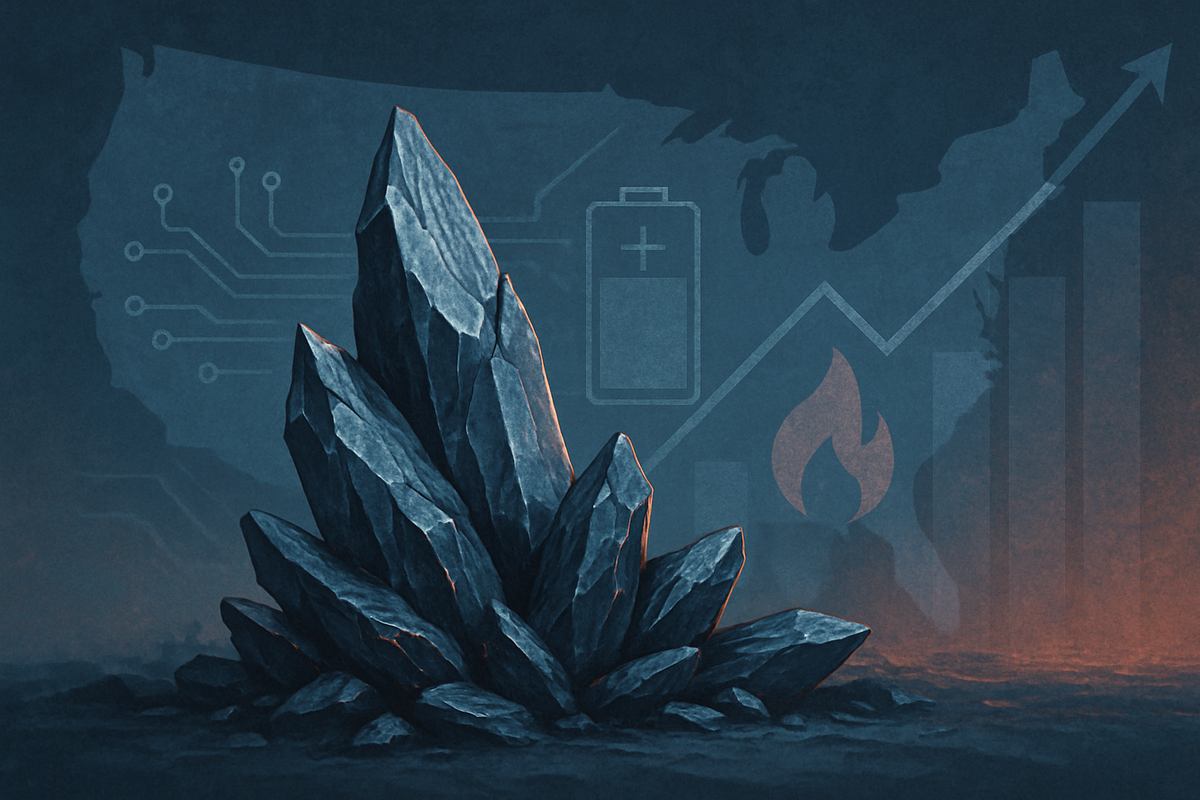
The United States Antimony market is on the precipice of a significant expansion, driven by escalating demand across vital industrial and defense sectors, coupled with an urgent national imperative to secure domestic supply chains. Recent market analyses project robust growth for this critical mineral, signaling a transformative period for both established players and emerging ventures within the sector. This upward trajectory is not merely a reflection of increasing industrial consumption but also a strategic response to geopolitical pressures and a profound reliance on foreign sources for a mineral deemed indispensable for national security and economic prosperity.
With the U.S. currently importing 85% to 90% of its antimony requirements, primarily from China which dominates global production, the push for domestic resilience has never been more pronounced. The projected market growth, reaching figures like USD 487.6 million by 2030 from an estimated USD 352.2 million in 2023, underscores a strategic pivot towards onshoring and diversifying antimony sources. This shift carries immediate implications for manufacturing, defense, and technology sectors, all of which heavily rely on antimony for a myriad of applications ranging from flame retardants to advanced electronics and ammunition.
Detailed Coverage: A Critical Mineral's Ascent
The anticipated surge in the U.S. Antimony market is underpinned by a confluence of factors, primarily the escalating demand from key strategic sectors and a concerted governmental push to fortify domestic supply chains. The market, valued at approximately USD 270 million in 2024, is forecast to potentially double to USD 550 million by 2035, demonstrating a compelling Compound Annual Growth Rate (CAGR) of 6.68% from 2025 to 2035. This growth is largely fueled by the indispensable role of antimony in flame retardants, particularly for OSHA-regulated clothing, which alone is projected to drive the market to USD 106.57 million by 2032. Antimony trioxides remain the dominant product segment, expected to command a 62% market share in 2025, with flame retardants constituting the leading application at around 42% of total demand in the same year.
The timeline leading to this critical juncture highlights a growing awareness of antimony's strategic importance. Designated a critical mineral by the U.S. Department of Interior in 2018, its high supply risk has been a persistent concern, exacerbated by the cessation of domestic commercial antimony production in the U.S. between 2016 and 2020. This vulnerability has been further underscored by China's recent implementation of stricter export controls on antimony in 2024, citing national security, which has sent ripples through global supply chains and intensified the urgency for the U.S. to establish self-sufficiency.
Key players and stakeholders are rapidly mobilizing to address this challenge. The U.S. Defense Logistics Agency (DLA) recently awarded United States Antimony Corporation (NYSE: UAMY) a substantial five-year contract worth up to $245 million to supply antimony metal ingots for the National Defense Stockpile. This contract is particularly significant as UAMY operates the only two antimony smelters in North America capable of processing the metal to stringent military specifications. Furthermore, UAMY is actively expanding its Thompson Falls, Montana processing facility by over 400%, with completion anticipated by early 2026, and is developing additional domestic projects in Alaska and Montana. Alaska Range Resources (ARR) has also received $43.4 million in funding from the U.S. Department of Defense to establish a secure antimony supply chain in Alaska. The Stibnite Gold Project in North America represents another crucial undeveloped antimony resource, with the potential to supply approximately 35% of U.S. antimony demand. Companies like Locksley Resources (OTCQB: LKYRF) are also advancing antimony projects in the U.S., such as the Mojave Project in California, and collaborating on domestic processing technologies.
Initial market reactions have been characterized by significant price volatility, reflecting the tight supply and increasing demand. Antimony prices surged by 54% in 2024, reaching $17,588 per metric ton in May 2024, and climbing further to $22,700 per ton in Europe by June 2024. By 2025, prices had soared to an astonishing US$51,500/ton, indicating the profound impact of supply constraints and geopolitical factors on this essential commodity. This price escalation underscores the critical need for diversified and stable supply sources to mitigate market instability and ensure consistent availability for crucial applications.
Corporate Fortunes in Flux: Winners and Challengers in the Antimony Resurgence
The burgeoning Antimony market in the U.S., driven by an urgent push for domestic supply chain security, is set to redraw the landscape for various public companies, creating significant opportunities for some while presenting considerable challenges for others. The strategic pivot away from heavy reliance on foreign imports, particularly from China, directly impacts entities involved in mining, processing, and critical end-use applications like flame retardants, batteries, and defense.
Leading the charge among the beneficiaries is United States Antimony Corporation (NYSE: UAMY). As the operator of the only significant antimony smelter in the U.S. (Thompson Falls, Montana) and another in Mexico, UAMY is uniquely positioned. The company's proactive strategy to restart domestic mining operations in Montana and acquire new claims in Alaska aims to establish a fully integrated "mine-to-market" supply chain within the U.S. This vertical integration, combined with its status as the sole vertically integrated antimony supplier in the Western Hemisphere, has already yielded substantial results. A pivotal moment was the $245 million sole-source, five-year contract awarded by the U.S. Defense Logistics Agency (DLA) to supply antimony metal ingots for the National Defense Stockpile. This contract, with an initial delivery order of approximately $10 million, directly addresses the near depletion of the U.S. antimony stockpile, cementing UAMY's role as a cornerstone of national security mineral supply. With significant equity raises and over $33 million in cash for expansion, UAMY is poised for substantial increases in revenue and profit, further bolstered by plans to expand its Montana facility's processing capacity by over 400% by December 2025.
Another significant winner is Perpetua Resources Corp. (NASDAQ: PPTA), the developer of the Stibnite Gold Project in central Idaho. This project holds an estimated 148 million pounds of antimony—the largest domestic reserve in the U.S.—alongside substantial gold deposits. With government approval received in September 2025 to commence mine construction, Perpetua is on track to become America's most promising opportunity for domestic antimony production, capable of supplying up to 35% of U.S. antimony demand in its first six years of operation. The company is actively forging strategic partnerships with major players like Clarios, Glencore, Nyrstar, Sunshine Silver, and Trafigura for antimony processing and off-take agreements, and is collaborating with the U.S. Army on downstream processing for defense applications. Federal funding, including $84.8 million under the Defense Production Act, underscores its strategic national importance and significantly enhances its financial outlook through future revenue generation. Locksley Resources (OTCQB: LKYRF), a U.S.-focused critical minerals company advancing high-grade antimony at its Mojave project in California, is also set to capitalize on this trend. With a goal to establish a "100% Made in America Antimony" supply chain and partnerships for advanced processing technology, Locksley is well-positioned to benefit from U.S. government policies, Department of Defense initiatives, and robust funding for its drilling programs in 2025.
Beyond primary producers, major consumers of antimony, such as Clarios (a global leader in advanced energy storage solutions and battery technology), stand to gain from a more stable and domestically sourced supply. Antimony is crucial for enhancing the durability of lead-acid batteries, and securing a domestic supply chain would provide greater price stability and reduce vulnerability to international market fluctuations. Similarly, major defense contractors like General Dynamics (NYSE: GD), Lockheed Martin (NYSE: LMT), and Raytheon Technologies (NYSE: RTX) will benefit immensely from a secure domestic antimony supply. Antimony is essential for various defense applications, including ammunition, laser-guided missiles, night vision goggles, and flame-retardant materials for military vehicles. A reliable domestic supply ensures operational continuity, enhances military readiness, and strengthens their position as key government contractors.
Conversely, manufacturers heavily reliant on historically cheaper imported antimony, particularly from China, are likely to face significant shifts and potential challenges. The new market dynamics, driven by domestic sourcing mandates and China's export restrictions, will compel these companies to re-evaluate their procurement strategies. They may incur increased raw material costs by transitioning to higher-cost domestic suppliers or diversifying imports from other countries like Australia, Bolivia, Chad, and Peru. Companies that fail to adapt swiftly by securing domestic or diversified sources may see their competitive advantage erode, potentially impacting profit margins and necessitating price adjustments for their end products. While large corporations are likely to adapt through new agreements, the initial transition could present operational and cost pressures for companies utilizing antimony in flame retardant plastics, certain electronics, and some battery manufacturers not yet aligned with domestic sourcing initiatives.
A Geopolitical Chessboard: The Broader Implications of Antimony's Resurgence
The projected growth of the U.S. Antimony market transcends mere economic expansion; it represents a critical inflection point in global resource security and a strategic recalibration of industrial supply chains. This development is deeply embedded within broader industry trends, reflecting a global scramble for critical minerals, the geopolitical weaponization of resources, and a renewed emphasis on national resilience.
At its core, the antimony market's trajectory is shaped by its designation as a critical mineral by the U.S. Department of Interior. This formal recognition underscores its indispensable role in national security and economic prosperity, particularly given its high supply chain risk. Antimony's applications are diverse and strategic, ranging from military uses in ammunition, night vision, and explosives, to essential components in flame retardants for OSHA-regulated clothing, plastics, and electronics, as well as crucial elements in lead-acid batteries and emerging technologies like liquid metal batteries and semiconductors. The U.S. has historically faced a significant vulnerability, with domestic antimony mining ceasing in 2020 and a staggering 85% to 90% reliance on imports, predominantly from China. This heavy dependence has spurred a concerted national effort to diversify supply chains and re-establish robust domestic production capabilities, a trend that is profoundly reshaping the mineral landscape.
The ripple effects of this shift are far-reaching. On a global scale, increased U.S. domestic production and reduced reliance on imports will inevitably impact dominant foreign producers, notably China, Tajikistan, and Russia. This could lead to a more diversified and potentially less volatile global antimony market, as the ability of a few nations to control prices and supply diminishes. Conversely, domestic partners are poised for significant gains. U.S. mining and processing companies, such as United States Antimony Corporation (NYSE: UAMY), Perpetua Resources Corp. (NASDAQ: PPTA), Locksley Resources (OTCQB: LKYRF), and Alaska Range Resources, are receiving substantial federal investment and support to develop new antimony projects and expand existing facilities. End-use industries across defense, automotive, electronics, and construction will benefit from a more secure and stable domestic supply, mitigating their vulnerability to international disruptions and price volatility. Furthermore, the U.S. is actively forging new supply partnerships with allied nations, exemplified by a recent US$500 million deal with Pakistan to export critical minerals, including antimony, to the U.S., contributing to collective security and diversified global access.
Regulatory and policy frameworks are playing a pivotal role in orchestrating this transformation. The Defense Production Act (DPA) has been instrumental in channeling federal investment into domestic critical mineral projects, such as the $43.4 million award to Alaska Range Resources for a comprehensive antimony production hub. This highlights a strategic focus on building integrated domestic supply chains from extraction to refinement for military-grade antimony. While the development of domestic mining and processing facilities faces stringent environmental and permitting challenges, the U.S. government is exploring regulatory streamlining to accelerate timelines while maintaining environmental protections. Strategic stockpiling and procurement, demonstrated by the DLA's substantial contract with UAMY to replenish the National Defense Stockpile, further underscore the government's commitment, providing market validation and encouraging private investment.
This current drive to bolster the U.S. antimony market is not without historical precedent, drawing critical lessons from past experiences with other critical minerals. The 2010 Rare Earth Elements "wake-up call," when China severely restricted exports, caused global prices to skyrocket and prompted widespread efforts in Western nations to diversify REE supply chains. More recently, China's 2023 export restrictions on germanium and gallium further illustrated its willingness to leverage critical mineral dominance for geopolitical advantage. The U.S. strategy for antimony directly reflects these lessons, emphasizing reduced foreign dependency, investment in integrated domestic production, development of recycling technologies, exploration of material alternatives, and the cultivation of international partnerships. These experiences underscore the long-term geopolitical and economic risks associated with concentrated critical mineral supply chains, making the projected growth in the U.S. antimony market a pivotal development in the ongoing quest for global resource security.
The Road Ahead: Navigating Antimony's Future Landscape
The U.S. Antimony market stands at a critical juncture, with its projected growth offering both immense opportunities and significant challenges. The path forward will be defined by a delicate balance between leveraging escalating demand and mitigating the profound risks associated with entrenched import dependency and geopolitical volatility.
In the short term (1-3 years), the market is likely to remain characterized by continued supply chain disruptions and price volatility. Efforts will intensify to diversify antimony import sources beyond traditional suppliers like China, with countries like Tajikistan emerging as increasingly vital partners. Crucially, this period will see the initial ramp-up of domestic production and processing capabilities. Companies like United States Antimony Corporation (NYSE: UAMY) are actively expanding their facilities and restarting domestic mining, while Perpetua Resources Corp. (NASDAQ: PPTA) is expected to commence construction on its Stibnite Gold Project, with potential first production by 2027-2028. Direct government support, exemplified by the substantial contracts from the U.S. Defense Logistics Agency and Pentagon awards, will be instrumental in accelerating these domestic initiatives. Despite these efforts, global supply shortages and persistent demand will likely sustain high and volatile antimony prices.
Looking further ahead (beyond 3 years), the long-term possibilities center on establishing a more resilient and self-sufficient U.S. supply chain. As major projects like Stibnite Gold and Alaskan initiatives come online and scale up, the U.S. could significantly reduce its import dependency, leading to greater price stability and predictability for domestic manufacturers. This period will also likely witness enhanced recycling infrastructure, driven by advancements in technology for extracting antimony from lead-acid batteries and e-waste, though historically, recycling has met only a small portion of demand. Research into antimony alternatives and more efficient use of the mineral will accelerate, particularly if prices remain elevated, though direct substitution remains challenging due to antimony's unique properties. The U.S. government's commitment to strategic stockpiling will also continue to play a vital role in mitigating future supply risks for national defense.
To navigate this evolving market, several strategic pivots and adaptations are paramount. Foremost is sustained investment in domestic mining and processing, requiring substantial capital, streamlined permitting, and effective environmental management. Diversification of supply chains, both domestically and internationally, will be critical to reduce over-reliance on any single source. Investing in advanced recycling technologies and continuous R&D for substitutes are essential for long-term sustainability and resilience. Crucially, robust public-private partnerships will be vital for funding, risk-sharing, and accelerating the development of a comprehensive domestic supply chain.
Market opportunities are abundant, fueled by growing demand for flame retardants (driven by stringent safety regulations), the expansion of the electronics industry, and the transition to clean energy technologies. The national security imperative for antimony ensures sustained government interest and investment, while "Buy American" initiatives will create a protected market for U.S. producers. High global antimony prices also make domestic mining projects more economically viable. However, significant challenges persist, including the historical dominance of foreign supply, ongoing geopolitical risks, and the inherent environmental and economic hurdles associated with developing new domestic mining and processing facilities. High capital costs, long lead times, and the inherent volatility of commodity markets also present considerable risks.
Potential scenarios for the U.S. antimony market range from a "Status Quo Plus," where the U.S. gradually diversifies imports and slowly ramps up domestic production, to an "Accelerated Domestic Resilience" scenario, where substantial government investment and successful private initiatives lead to significant domestic capacity within the next decade, dramatically reducing import dependency. A more pessimistic "Supply Shock and Substitution" scenario could emerge if severe global disruptions lead to extreme price spikes, forcing industries to aggressively seek out alternatives or reduce antimony content, potentially dampening long-term demand for the mineral itself. The ultimate outcome hinges on the success of these concerted efforts to bolster domestic production, diversify international sourcing, and advance recycling technologies, ensuring a secure and stable supply for critical U.S. industries.
A Critical Mineral's Ascent: The Antimony Market's Transformative Path
The U.S. Antimony market is undergoing a profound transformation, driven by an intricate interplay of escalating industrial demand, national security imperatives, and a strategic realignment of global supply chains. The projected significant growth, with market values potentially doubling by 2035, underscores antimony's indispensable role across diverse sectors, from advanced defense systems and crucial flame retardants to cutting-edge electronics and energy storage solutions. This shift is not merely economic; it's a critical national security endeavor aimed at mitigating vulnerabilities stemming from a historical 85-90% reliance on foreign imports, particularly from China, which has recently demonstrated its willingness to weaponize critical mineral exports.
Moving forward, the market will be defined by a determined pivot towards establishing domestic resilience. Key takeaways include the robust growth projections, the critical mineral designation emphasizing its strategic importance, and the aggressive pursuit of domestic mining and processing capabilities by companies like United States Antimony Corporation (NYSE: UAMY) and Perpetua Resources Corp. (NASDAQ: PPTA), heavily supported by substantial government contracts and funding. This proactive approach aims to stabilize supply, reduce geopolitical risks, and foster a more predictable environment for industries reliant on antimony. Despite the promising outlook, challenges such as environmental hurdles, high capital costs for new projects, and persistent price volatility due to global supply constraints will need careful navigation.
The lasting impact of this market realignment will be a more secure and stable supply chain for a mineral vital to U.S. industrial resilience, technological innovation, and national defense. This fundamental shift towards self-reliance minimizes dependence on potentially volatile foreign sources and strongly supports the broader "Made in America" initiative for critical raw materials.
For investors, the coming months will offer crucial signals. Watch for further government contracts, grants, and policy directives that reinforce domestic antimony production, as these provide significant revenue visibility and strategic advantage. Monitor the progress of production capacity expansions from key players like UAMY and the development of new mining projects within the U.S. and allied nations, as their success will directly impact long-term supply. Keep a close eye on price stability and volatility, as global supply-demand dynamics, particularly from China, will continue to influence market trends. Finally, track technological innovations in antimony applications, especially in advanced semiconductors and next-generation batteries, as these could open new avenues for growth. The U.S. Antimony market is in a transformative period, and a nuanced understanding of its industrial applications, geopolitical undercurrents, and emerging domestic capabilities will be essential for investors navigating this evolving landscape.
This content is intended for informational purposes only and is not financial advice





